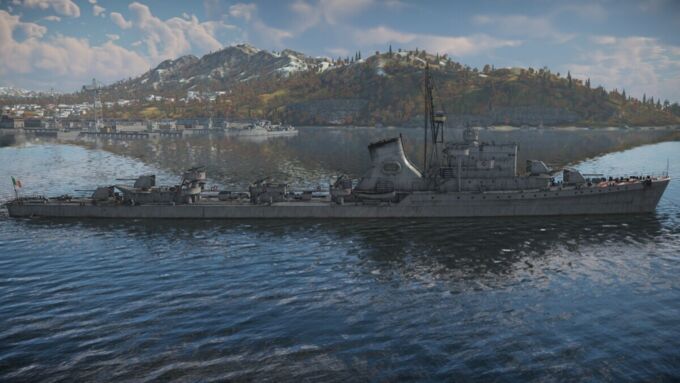During World War II, the Regia Marina did not have enough destroyers available. By September 1940, 7 destroyers had been lost in combat, so a decision was initiated to build 7 new destroyers to replace them.
To save development and design time, a new batch of the existing Soldati-class destroyers were ordered.
These new Soldati-class destroyers got an additional 100 tons more in weight because of the new anti-aircraft and anti-submarine armament which was updated, the construction of the first units took place in October 1940 and 5 ships entered service between February and August 1942.
During World War II, the armament of the Soldati-class ships was modified several times and upgraded, eliminating a row of torpedo tubes and replacing them with anti-aircraft armament.
During 1941, while the second series of Soldati-class destroyers were being built, it became clear that more destroyers had to be built, in fact the Navy Ministry decided to incorporate all changes on destroyers, based on the experience gained in the war, so it was understood that a new class of destroyers had to be developed.
The committee assigned the task of designing the new class to General Carlo Sigismondi (Corpo del Genio Navale) who was assisted by Lieutenant Colonel Giuseppe Malagoli (Corpo del Genio Navale). The new class was practically an update of the Soldati class with the addition of more weight, the design of the ship changed in almost all parts except the layout of the engines which did not change, but the engines were upgraded to 60,000 horsepower.
The speed was reduced to 35 knots, a speed considered sufficient for all the missions that the new class of destroyers had to perform.
The first drawings of the projects were made quickly and the first orders were placed in September 1941, the construction of the first two units took place in the Cantieri del Tirreno di Riva Trigoso on 10 September 1941, while other two units were allocated in the Cantieri Navali Riuniti di Ancona and four units were allocated in the Cantieri Navali Odero Terni Orlando (OTO) di Livorno on 27 September 1941.
After these 8 units it was planned to produce a second series of this class of ship, the significant change of this new class was the replacement of the twin 120 mm/50 guns with single 135 mm/45 guns, then as anti-aircraft armament it was composed of 12 Breda mod.39 37 mm/54 cannons, the initial designs of the class when completed showed that the ship would normally be 2,600 tons of weight, 120 m in length, with a smokestack that was clearly inspired by the Soldati class.
During 1942, the project was again modified by eliminating the fifth gun positioned in the center of the ship to accommodate more anti-aircraft armament, in September 1942 the design was blocked in the same month orders were placed for 8 units of the second series (2 in Trigoso, 2 in Livorno and 4 in CRDA Trieste).
Later there was also a modification for the elimination of the stern director to favour the addition of more anti-aircraft armament.
Orders were placed for 8 units of the third series on 7 October 1942 with CRDA Trieste.
The name of the new class was called: Comandante Medaglie d'Oro. This name was chosen to remember the commanders who had received the gold medal (Medaglie d'Oro).
In the end, between May 1944 and January 1945, aerial bombardments were carried out on the shipyards where the ships were being built, as a result of the damage they were demolished.
Planned units
- Comandante Margottini
- Comandante Baroni
- Comandante Borsini
- Comandante Botti
- Comandante Casana
- Comandante Corsi
- Comandante De Cristofaro
- Comandante Dell'Anno
- Comandante Esposito
- Comandante Fiorelli
- Comandante Fontana
- Comandante Giannattasio
- Comandante Giobbe
- Comandante Giorgis
- Comandante Milano
- Comandante Moccagatta
- Comandante Novaro
- Comandante Rodocanacchi
- Comandante Ruta
- Comandante Toscano

